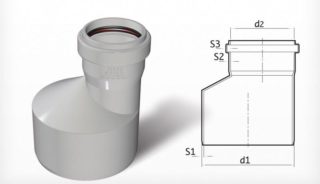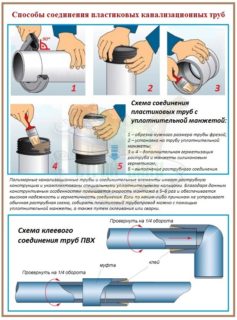To create an ideal sewer network, pipes alone are not enough. It is necessary to select high-quality connecting elements - adapters. They perform different functions and can be made of cast iron, steel, copper, polymeric materials - polyvinyl chloride and polypropylene. The operation of the entire waste pipeline depends on the correct selection of fittings.
Purpose of sewer adapters
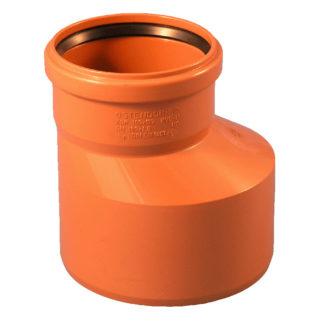
Many shaped elements have been invented, and each has its own purpose. The general purpose of their application is to create highways of complex configuration and save space without losing quality capabilities.
With the help of sanitary fittings products:
- carry out the transition to another size of the pipe section;
- change the direction of the highway;
- drain sewer and remove aggressive drains.
Adapters allow you to assemble pipe sections of different sections into a single whole, connect metal and plastic branches, connect any plumbing. They come in handy if you need to bring threaded elements to the unpressurized part of the pipeline, which are used to equip pumps for pumping and treating wastewater. To further save space, products can be corrugated so that they can take any shape.
Types and design features
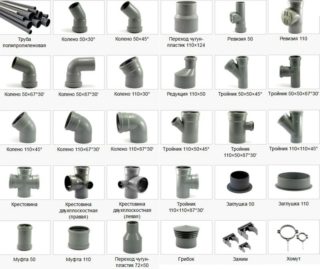
Most types of transition elements are used in both external and internal sewerage systems. They, like pipes, differ in shade. Outside they put red products, inside - gray and white.
The most popular fittings with transition function:
- Adapter. Designed to connect connectors with union nut to fittings with tapered outlets of the corresponding diameter - manifolds or valves.
- Fitting. Connects a plastic drain hose to a metal pipe.
- Swivel elbow with 90, 30 and 45 degree angles. Needed to change direction. There are options with a thread for easy connection of the mixer.
- Cross and tee. Shaped elements allow you to connect several pipe sections, sometimes with different sections, into one unit. Metal elements can be provided with internal or external threads.
- Coupling. Its use is advisable if the pipes to be connected have the same diameter and wall thickness.
- Reduction. It is necessary to connect parts of different diameters.
- Bypass. The curved part is used to reduce the number of docking points, which reduces the risk of accidents.
- Compensator. Able to give the desired slope to horizontal sections of the line, smooth out temperature drops, soften water hammer. Without it, sections of the system can deform.
- Saddle. The part has two parts that crimp the pipe. It is needed in order to correctly perform a tie-in into the pipeline system.
- Two-knee siphon. The part is installed in places where wastewater is received. Eliminates toxic gases and improves ventilation. At home, bottle products of a similar configuration are used to collect wastewater under sinks and washbasins.
Revision hatches are also referred to as transitional elements. Revisions are needed so that the plumber can check the condition of the sewer system, and, if necessary, clear the blockages through them.
All shaped transition elements are classified as either concentric or eccentric.The former are suitable for vertical installation of the pipeline, the latter - in the horizontal.
Manufacturing material
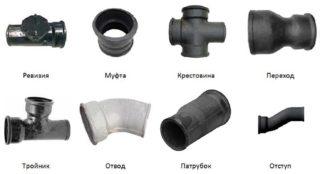
At home, plastic pipelines are most often installed. In accordance with the material of manufacture of the main branches, adapters are chosen from polypropylene or PVC.
The advantages of polymer elements:
- impossibility of corrosion;
- light weight;
- ease of installation;
- a large assortment;
- budgetary cost;
- no need to use a specialized tool during installation.
Polypropylene parts create a greater tightness of the joint, especially if it is made by welding. The work is carried out with a special soldering iron and special attachments.
The disadvantages of plastic products include lower strength in comparison with metal ones. They cannot withstand extremely high or low temperatures, unnecessarily aggressive chemical attack. But in everyday life there are no such extremes, and polymer elements are quite suitable for domestic sewage.
Cast iron products are strong, durable, resistant to water shocks and temperature extremes. They are also inexpensive. The only drawback is that the adapters are quite heavy.
Copper and steel (usually also with the addition of copper) parts are used where a threaded connection cannot be dispensed with. The cut can be applied both inside and outside. These are durable yet lightweight products. To improve their anti-corrosion properties, they are coated with zinc or nickel spraying. The disadvantage is the price - such parts are more expensive than analogues made of other materials and are not always suitable for polymer pipelines.
Dimensions and recommendations for selection
- for internal lines - from 50 mm;
- for the outer part of the pipeline - from 110 mm;
- for a sewer grid for several buildings - from 315 mm;
- for a centralized city-wide system - from 630 mm.
To choose the right adapter for the sewer pipe, you need to consider where this segment will be located. Waste water from the bath, shower, washbasin is discharged through pipes with a cross section of 50 mm or more. Sewage from the toilet must go through a line with a diameter of at least 110 mm. The desired diameter of the risers is from 150 mm.
Going for building materials, create a drawing of the sewer to scale. This will help to clarify the length of all pipe sections, the number of fittings of different types. In order not to be mistaken with the dimensions, decide whether the shaped element will be put on the pipe or inserted into it. If possible, use contours to reduce the number of sidebars.
Calculate the bend angle exactly. The smaller it is, the better the sewage system functions. All internal bends accumulate odor-causing dirt and pressure in the network.
The price of sewer adapters is low: a reduction can cost from 20 to 200 rubles, a branch - from 100 to 350 rubles, a tee or a cross - from 200 to 500 rubles, a coupling - from 100 to 250 rubles. The average cost of revisions is 500 rubles.
Installation features
The installation of this part on a cast iron pipe is carried out in two ways. In the first case, the cuff is placed from the inside. The docking area is preliminarily cleaned of dirt and rust, treated with sandpaper and covered with plumbing grease. Then the cuff is installed and another piece of pipe is inserted. This method is possible only if there is a socket on the pipe section. If not, the cuff is installed outside:
- The outer surfaces of pipe sections are cleaned of dirt deposits and polished.
- At the ends on the outside, small chamfers are made for the convenience of putting on the cuff.
- Sealing silicone is applied to the ends of the pipes, and they are connected using a rubber adapter.
Usually, one of these docking methods is chosen if a connection of cast iron and plastic sewer branches is required.
In polymer systems, the connection is made by an inner O-ring. Structurally, this is already provided by the manufacturer. The part is pushed onto the smooth end of the pipe section, after which an adapter is put on from above. However, this method is only suitable for indoor gravity drainage. External elements in pressure networks are additionally sealed with a special adhesive:
- The end of the pipe is treated with sandpaper.
- Apply the adhesive mixture at a distance of about two centimeters from the edge.
- Wait two minutes for the glue to thicken.
- Insert the pipe piece into the corresponding hole in the adapter.
The sewer can be used when the mixture hardens (it depends on the composition and manufacturer). The time is indicated in the instructions for use.
For the assembly of polypropylene pipes and fittings, the welded method is often used using special soldering machines. Due to the fact that the products are made of a similar material, bonding occurs at the molecular level when the melted areas are connected.
Metal parts are connected by a threaded method or a linen seal is used for caulking. The slots between the flax wound on the pipe and the adapter are filled with cement mortar. Jacketed connections are reliable but difficult to dismantle.
Sometimes, only a moisture-resistant sealant is used to connect a pipe segment and a shaped part. This method is simple and affordable: it is enough to apply the composition on the surface, connect them and wait for polymerization (from 4 hours to a day). But this is advisable if the cross-section of the pipe is small, and the gaps are less than 2 mm. Otherwise, it is better to use a combination of sealant and o-ring, rubber sleeve, or linen fiber.
The choice of high-quality and reliable parts for connecting pipe sections is a guarantee that the drainage system will work reliably and will not require repair for a long time.

